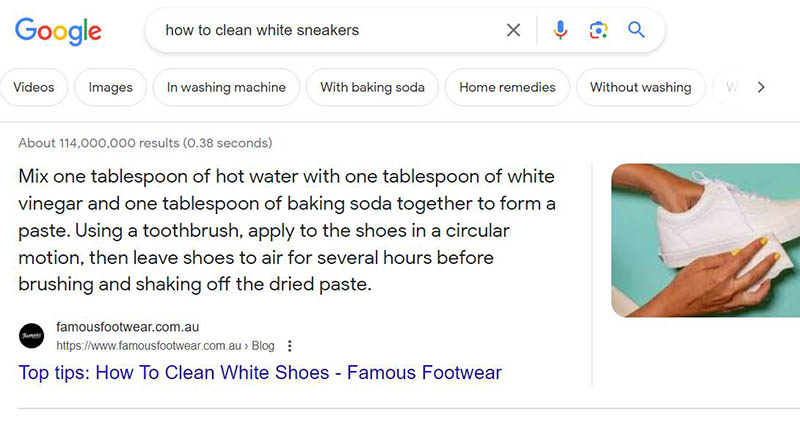Search intent (a.k.a user intent) refers to the goal behind a user’s search query.
When you type a query into a search engine, you have an objective in mind: seeking information, making a purchase, or finding a specific website.
When you create content, consider your audience’s needs and what you can do to satisfy them.
For instance, if you’re writing a blog post to rank for an informational query, focus on providing valuable information and delivering accurate, well-researched content.
By understanding and addressing search intent in your content, you can improve your SEO efforts, attract the right audience, and increase user satisfaction.
The key is always to provide value and help your readers achieve their goals while maintaining a friendly tone.
What are the Different Types of Search Intent?
1. Informational
Informational intent refers to searches where users seek to gain knowledge or learn something new.
For example, “How do you tie a tie?” or “What is the weather like today?”

To satisfy informational intent, your content should provide valuable and well-organized information that answers the users’ questions comprehensively and concisely.
You can use heading tags, lists, and bold text to emphasize essential details.
2. Navigational
Navigational intent is when users already have a specific website or resource in mind and turn to search engines to find it.
Common examples include searching for the name of a company or a popular website, such as “The New York Times” or “YouTube.”
For navigational intent, your website should have clear, concise titles and metadata to help users quickly identify the correct destination.
Also, a well-structured site hierarchy will assist search engines like Google or Bing to direct users to the appropriate pages.
3. Transactional
Transactional intent pertains to users ready to purchase or complete a specific action, such as downloading an app or signing up for a service.
Searches with transactional intent often include terms like “buy,” “price,” or “discount.”
You should optimize your product pages and calls-to-action (CTAs) to make purchasing seamless.
Ensure that your eCommerce platform is mobile-responsive and easy to navigate.
4. Commercial
Commercial intent is when the reader is in the buying process’s research phase. Before purchasing, they may search for product reviews, comparisons, or other information.
Example Queries: “best wireless headphones” or “top website builders.”

To address commercial intent, create in-depth, informative content that presents your products or services as worthwhile options and explain the benefits, features, pros, and cons. Include relevant links and CTAs to guide users toward eventually purchasing.
Why is Search Intent important?
a. User Experience
It significantly improves the user experience. By catering to the user’s intent, you can craft a more personalized and engaging experience for your visitors.
This includes providing content that addresses their specific needs, presenting it in a user-friendly format, and organizing your site in a way that is easy to navigate.
b. Keyword Research
Understanding search intent is crucial when conducting your keyword research. Identifying the primary goal behind a user’s query can help you choose the most relevant and targeted keywords for your content.
Your page’s visibility in search results will improve, leading to an increase in organic visitors.
c. Content Creation
When you create content with search intent, you can better meet your audience’s needs and desires.
Your information becomes more useful and relevant to the reader, which increases the likelihood of attracting more visitors to your website and improves conversion rates.
d. Rankings and Visibility
Focusing on search intent can positively impact your site’s rankings in search engines. When your content aligns with the user’s query, it is more likely to be relevant.
This can improve visibility and higher rankings, which leads to more organic traffic.
How to Determine Search Intent?
Look for words that indicate a specific type of intent, such as “how to,” “buy,” “compare,” or “best.” These words can hint at what the user wants to achieve with their search.
Another way is to examine the search engine results page (SERP) for the given query. Pay attention to the top-ranking pages and the types of content they provide.
The search intent is likely informational when most of the results are blog posts or articles. However, the intent may be transactional or commercial if you see product pages, webshops, or comparison websites.
To narrow it even further, analyze the content of the top-ranking pages. Identify common themes, topics, or structures.
For example, if multiple articles discuss a specific problem, the search intent could be problem-solving. If they provide step-by-step instructions, the search intent may be tutorial-based.
Keep in mind to consider the user’s stage in their journey. Early-stage searchers will likely have informational intent, while users further down the sales funnel may exhibit a transactional or commercial sense.
Additional Tips for Optimizing Search Intent
Start by analyzing what keywords your competitors are targeting, their content strategy, and the user experience on their websites. This way, you can gather valuable insights to guide your efforts and stay ahead in your niche.
Also, use that information to identify gaps in your strategy and make improvements. Optimizing for search intent is an ongoing process that requires continuous tuning and updates.
Once you’ve identified the right keywords, it’s time to create relevant content that corresponds to each keyword’s search intent. Make sure that your content is helpful, informative, and engaging.
Mainly target specific keywords relevant to your target audience. Analyze the keywords in your niche and select ones that reflect your audience’s needs and wants.
To find the best keywords, use tools like Google’s Keyword Planner, Google Search Console, and other SEO tools.
Don’t forget to focus on critical aspects like page load times, mobile responsiveness, simple navigation, and user-friendly design.
Lastly, make your landing pages engaging and optimized for the desired action, whether gathering contact information, purchasing, or signing up for a newsletter.

